 "user314" (user314)
"user314" (user314)
09/16/2020 at 11:00 ē Filed to: flightline, Planelopnik, planelopnik history, planes you've (probably) never heard of, What If?
 4
4
 12
12
 "user314" (user314)
"user314" (user314)
09/16/2020 at 11:00 ē Filed to: flightline, Planelopnik, planelopnik history, planes you've (probably) never heard of, What If? |  4 4
|  12 12 |
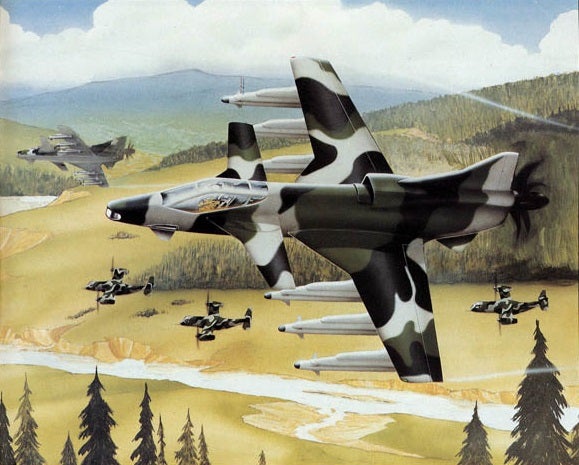
Two P.1233-1 escort a trio of V-22 Osprey in this artistís conception
In 1977, the !!!error: Indecipherable SUB-paragraph formatting!!! was passed in the UK, which called for the merger and nationalization of the remaining British aircraft manufacturers: !!!error: Indecipherable SUB-paragraph formatting!!! , !!!error: Indecipherable SUB-paragraph formatting!!! , !!!error: Indecipherable SUB-paragraph formatting!!! and !!!error: Indecipherable SUB-paragraph formatting!!! . The resulting firm was called !!!error: Indecipherable SUB-paragraph formatting!!! , which in addition to continuing to service legacy systems like the !!!error: Indecipherable SUB-paragraph formatting!!! , !!!error: Indecipherable SUB-paragraph formatting!!! , !!!error: Indecipherable SUB-paragraph formatting!!! , !!!error: Indecipherable SUB-paragraph formatting!!! and !!!error: Indecipherable SUB-paragraph formatting!!! , developed its own aircraft like the !!!error: Indecipherable SUB-paragraph formatting!!! family and the !!!error: Indecipherable SUB-paragraph formatting!!! .
One of
the projects BAe was also working on was Saba (Small Agile Battlefield
Aircraft), which was intended to hunt down Soviet helicopters like the
!!!error: Indecipherable SUB-paragraph formatting!!!
, as well as emerging threats like the
!!!error: Indecipherable SUB-paragraph formatting!!!
and
!!!error: Indecipherable SUB-paragraph formatting!!!
†
Vintoplan
tiltrotor.
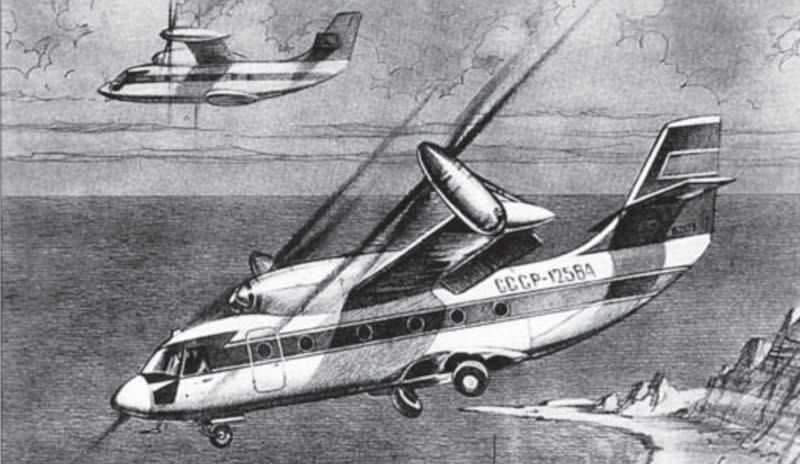
Two Mi-30 tiltrotor transports feature in this artistís impression.
BAeís Future Projects team, known as ĎKingstoní, began designing a new aircraft that could out maneuver helicopters as well as provide close-air support. The new plane would be able to operated day or night, from rough short fields, with a long loiter time as well as sufficient speed to reach targets quickly. The model P.1233-1 incorporated a canard, unswept wings, dorsal and ventral tail surfaces and !!!error: Indecipherable SUB-paragraph formatting!!! propulsion.
Development of propfans, also known as unducted fans or open rotor engines, began in the 1940s as research into turbojet engines and sweeping wing surfaces accumulated. Engineers reasoned that a jet engine coupled to a propeller made up of a number of highly-swept blades could match the performance of a turbojet, but maintain the fuel efficiency of piston engines. Early attempts ran into issues with materials, shaping and noise, so the idea was temporarily abandoned. Improvements in materials, especially resin-impregnated composites and the shaping there of, as well as expanded research into aerodynamics, reignited research into propfans in the 1960s and 1970s , with Hamilton Standard and General Electric both working on designs.
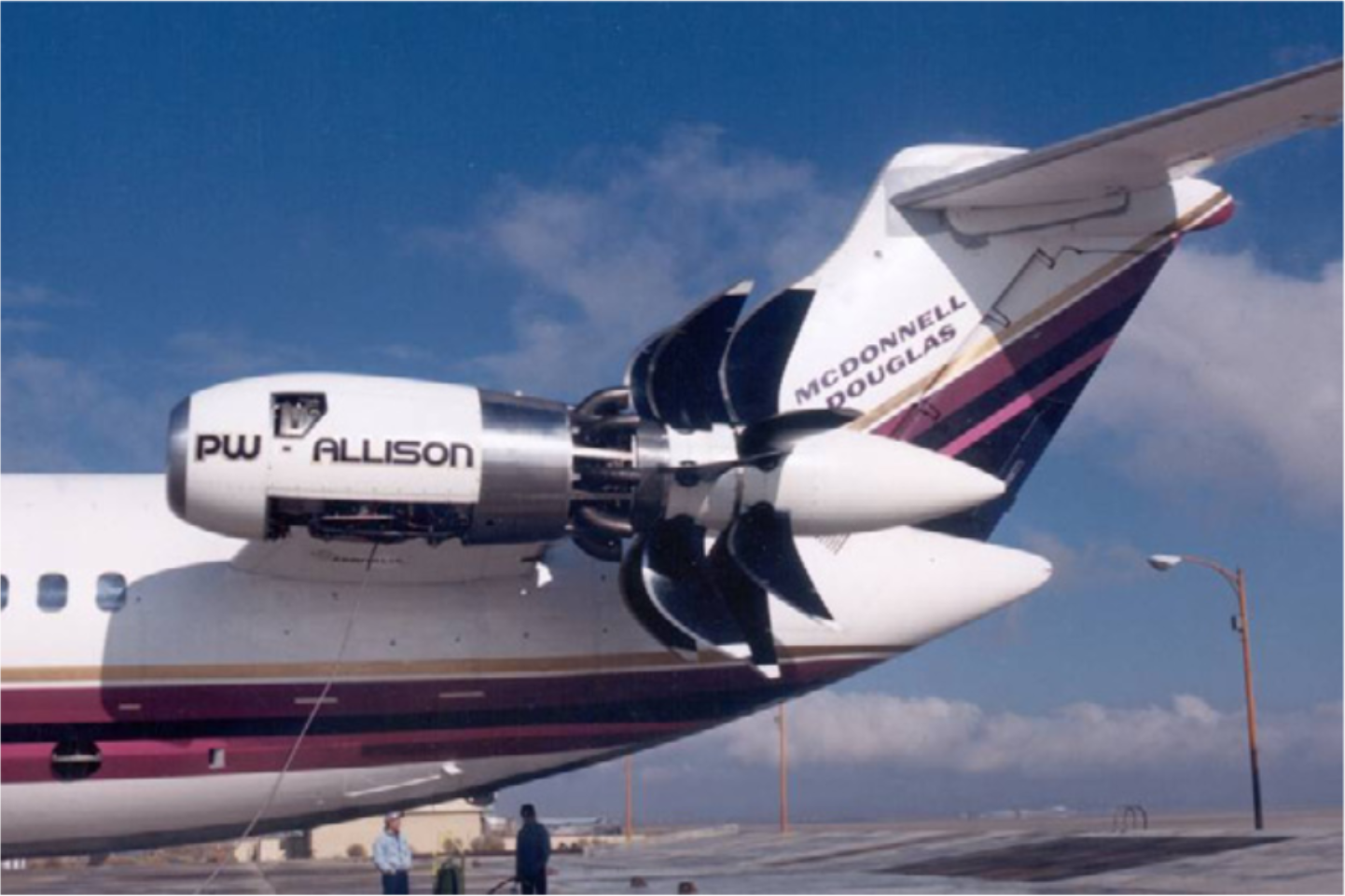
The Pratt & Whitney-Allison 578ĖDX geared propfan demonstrator engine, installed on an MD-80 testbed aircraft.
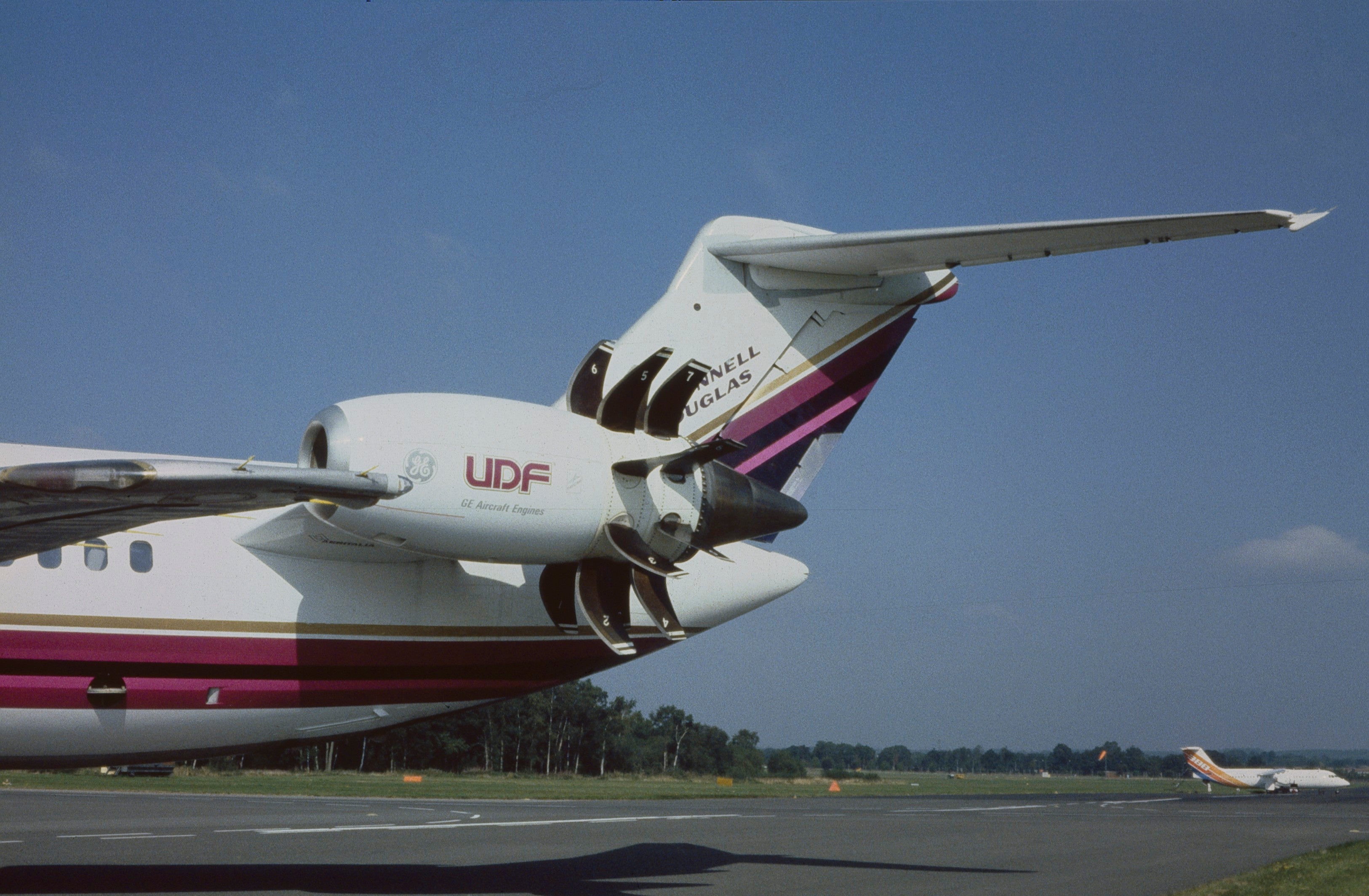 !!!CAPTION ERROR: MAY BE MULTI-LINE OR CONTAIN LINK!!!
!!!CAPTION ERROR: MAY BE MULTI-LINE OR CONTAIN LINK!!!
As its name implied, the P.1233 was small, with a wingspan of just 11m (36'), and light, maximum TO weight of under six tonnes (13,200lbs). This compactness allowed the P.1233 to turn 180į in 5 seconds and in a radius of just 150m (490'). The unique propfan engine, as well as the dorsal intake, would have reduced the SABAís IR fingerprint, and its low ceiling would have granted some measure of protection against radar-guided missiles. The P.1233's own armament consisted of six !!!error: Indecipherable SUB-paragraph formatting!!! air-to-air missiles as well as a 25mm canon.
Nose mounted sensors included an IR seeker and a laser designator, opening up the aircraft to carry ing anti-tank weapons such as the !!!error: Indecipherable SUB-paragraph formatting!!! , !!!error: Indecipherable SUB-paragraph formatting!!! , or the !!!error: Indecipherable SUB-paragraph formatting!!! missile.

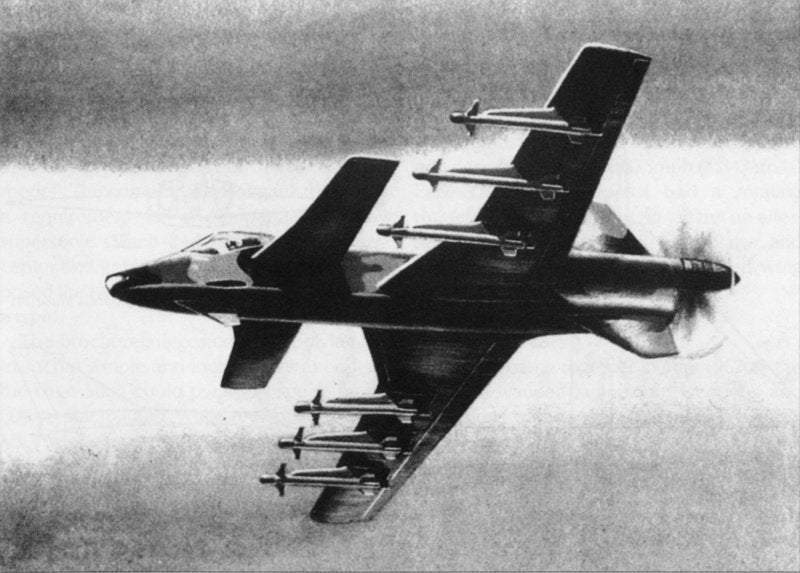
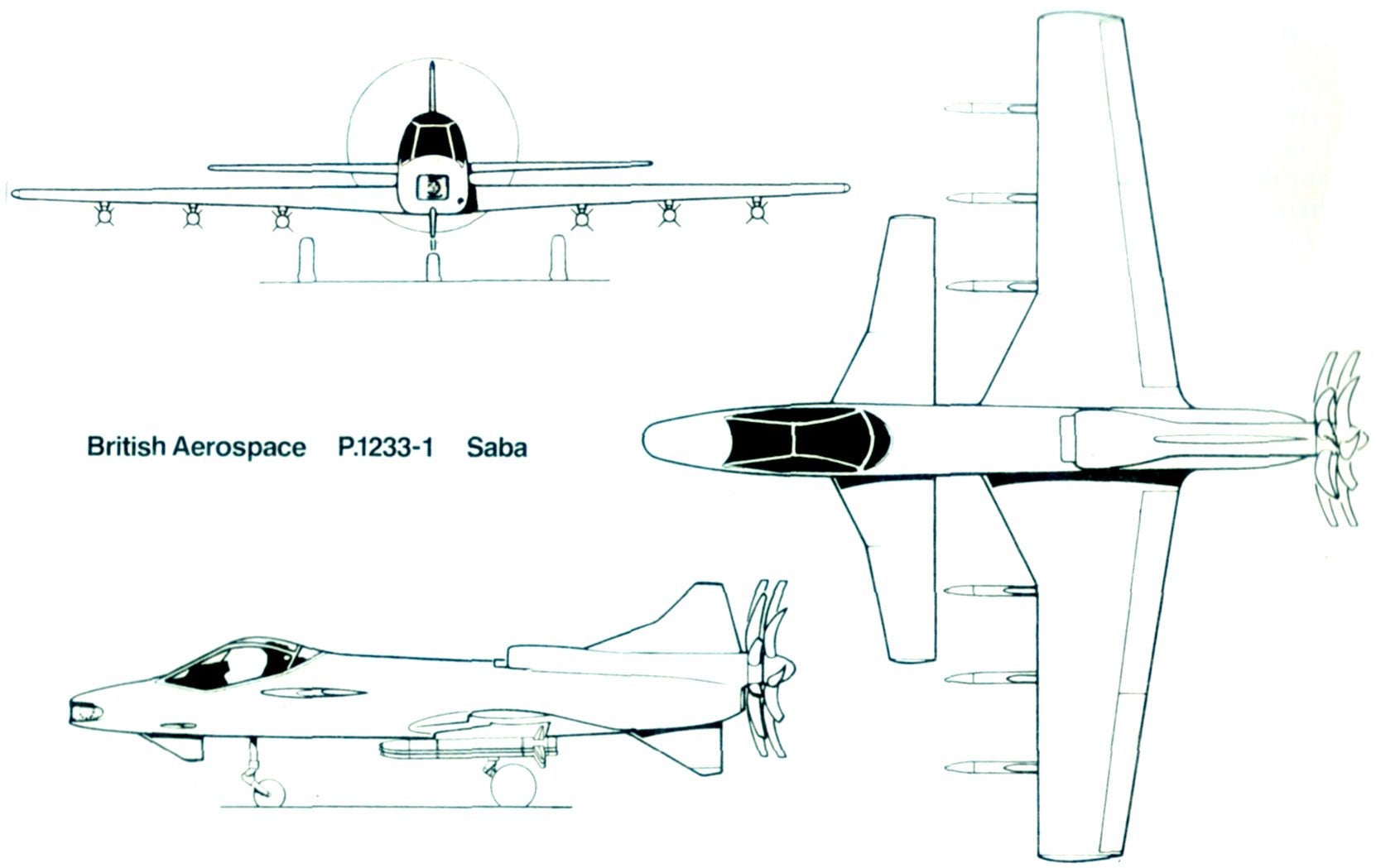
BAe also pitched the SABA to the US Army and USAF as a COIN/CAS aircraft, potentially supplementing or replacing the A-10 Thunderbolt II, but after initial interest both cooled on the idea. The RAF was similarly interested in the concept, but the collapse of the USSR and the end of the Cold War ended the program before a prototype could be built.
 ttyymmnn
> user314
ttyymmnn
> user314
09/16/2020 at 11:33 |
|
You could probably do a lot today† with that same design and a modern ducted turbofan. Being in the British aerospace design business must have been extraordinarily frustrating. Lots of great ideas, but a government that was more interested in buying American planes.†
 user314
> ttyymmnn
user314
> ttyymmnn
09/16/2020 at 12:04 |
|
I do not understand why the Brits went through the trouble of nationalizing their aviation industry, only to strangle it to death.†
 ttyymmnn
> user314
ttyymmnn
> user314
09/16/2020 at 12:06 |
|
Maybe they nationalized their aviation industry so the could strangle it to death. Itís bizarre.
 gmporschenut also a fan of hondas
> user314
gmporschenut also a fan of hondas
> user314
09/16/2020 at 12:52 |
|
Theyíre like 2nd or 3rd† in terms of manufacturing parts. Iirc it was a Mustard video, a major problem was the U.K. and the French could never get the volume to support standalone models.
 ttyymmnn
> user314
ttyymmnn
> user314
09/16/2020 at 13:18 |
|
Werenít those UDFs stupid loud?
Also this:
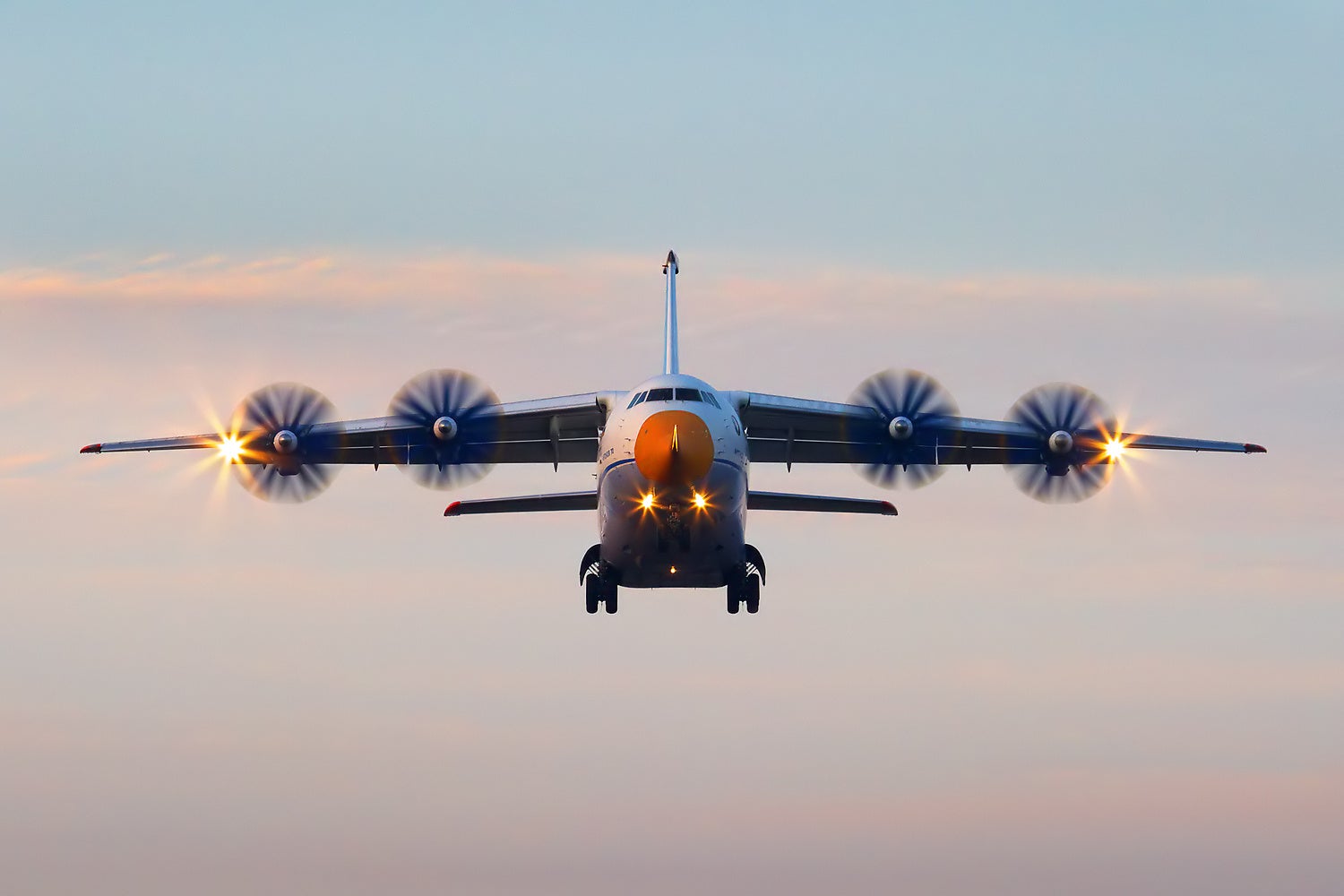
 user314
> ttyymmnn
user314
> ttyymmnn
09/16/2020 at 13:28 |
|
The first ones were, yeah. The trouble with propfans/UDFs is that the research into them is keyed to the price of oil, so development has been spotty at best. That, plus the crazy fast development and adoption of HBTFs has meant that propfans are pretty much a dead-end, developmentally .
 ranwhenparked
> user314
ranwhenparked
> user314
09/16/2020 at 13:29 |
|
You could say the same thing about their steel, shipbuilding, automotive, motorcycle, etc. industries. Most of them were troubled, but not terminally so before nationalization, but exited government ownership virtually dead. Basically, you put all your eggs in one basket, have only one company take up one entire sector of your economy, and all it takes is that one company failing to basically wipe out the whole industry, or nearly so. Also, taking dozens of firms that spent their whole lives as competitors to each other and trying to force them together into one cohesive company with unified management and minimized job losses just isn't going to happen.
 user314
> ranwhenparked
user314
> ranwhenparked
09/16/2020 at 13:54 |
|
Yup. Look at the absolute ruin Boeing has undergone since they incorporated the McDD people.†
 ranwhenparked
> user314
ranwhenparked
> user314
09/16/2020 at 14:14 |
|
The US aircraft industry probably hasn't been well served by having only one commercial builder.
 gmporschenut also a fan of hondas
> ranwhenparked
gmporschenut also a fan of hondas
> ranwhenparked
09/16/2020 at 22:39 |
|
Each of those industries had major problems. They didnít go into nationalization because they were healthy.
Automotive produciton though increased in the 50s and 60s was heavily manual which put them as a major problem as other the nations manufacturers were automating . The Uk was screwed when they were cut out of the EEC in the 60s and by the time they joined and dropped their protective tarrifs were flooded with newer cheaper models.
The steel industry was similar to the US surviving the war and hampered wiht outdated equipment.
And shipbuilding. 1880-1920s enormous growth as ships become obsolete less than a decade after construction, plus major arms race, and another burst in the late 30s-40s. by the end you have few rivals and a glut of supply.
https://www.ft.com/content/b672b262-3e75-11e9-b896-fe36ec32aece
 ranwhenparked
> gmporschenut also a fan of hondas
ranwhenparked
> gmporschenut also a fan of hondas
09/16/2020 at 23:11 |
|
I maintain that more would have survived, any merged entity is as strong as its weakest member. The idea of the positive traits of the strong partners cancelling out the weaknesses of the others never works in practice, the failing companies just drag everyone else down with them. If we had nationalized our steel industry, U.S. Steel, Nucor, Allegheny, etc, would have just been dragged down by Bethlehem Steel and sold off in pieces to the Indians. Instead, BethSteel was left to die and collapse on their own, and most of the rest survived. I suppose we could have forced Ford, GM, and Chrysler to merge together in 2009, but that would have been disastrous. Instead, 1 out of 3 ended up being able to limp their way out of it without nationalization, and 2 of 3 managed to survive as independent companies, whereas the creation of BL effective doomed most of what went into it. Leyland/Rover was a perfectly healthy company on their own, there was no solid business case for them to hitch their wagon to the dying horse of British Motor Holdings, except for pure politics, because Wilson didnít want to preside over the collapse of the countryís largest automaker, which ended up happening anyway, 6 years later.
If you want continuity of government after a nuclear attack, donít put all your cabinet members and other key officials in the same place during the attack. If you want your retirement savings to survive through recessions, donít invest it all in one stock or one industry. If you want a strategic industry thatís important to your nationís economy to survive in some form, donít let it all fall into the hands of a single corporation.
19 out of 20 competitors failing is still a better result than 1 out of 1 failing.†
 gmporschenut also a fan of hondas
> ranwhenparked
gmporschenut also a fan of hondas
> ranwhenparked
09/17/2020 at 08:27 |
|
I agree that shoving all the companies together was not a good long term policy. The problem was that after 1945 the UK aviation industry was massively decentralized. That can be a bonus during a wartime as no one plant can be bombed. the famous line that every piano company was pushing out mosquito parts isnít an exageration. however they went from one extreme end of the spectrum to the other.
dozens of small firms becomes a hindrance when it comes to designing a new fighter. 2 0 teams of 10 people are going to be slower than 2 teams of 100. The government didnít have time for firms to grow or rise or fall naturally. They also post- war ddinít have money to find out.†
ď The real problem was a lack of systems engineering expertise below top management. As a result, Britain could develop cutting-edge prototypes but could not manufacture large quantities of high-quality aircraft in a timely and economical manner. This problem prevailed not only in the aircraft industry but also in British manufacturing as a whole, contributing to the decline in national competitiveness from the 1950s onward.Ē
And currently in terms of production th e UK is the forth largest manufacturer, just now they produce components vs entire aircraft.